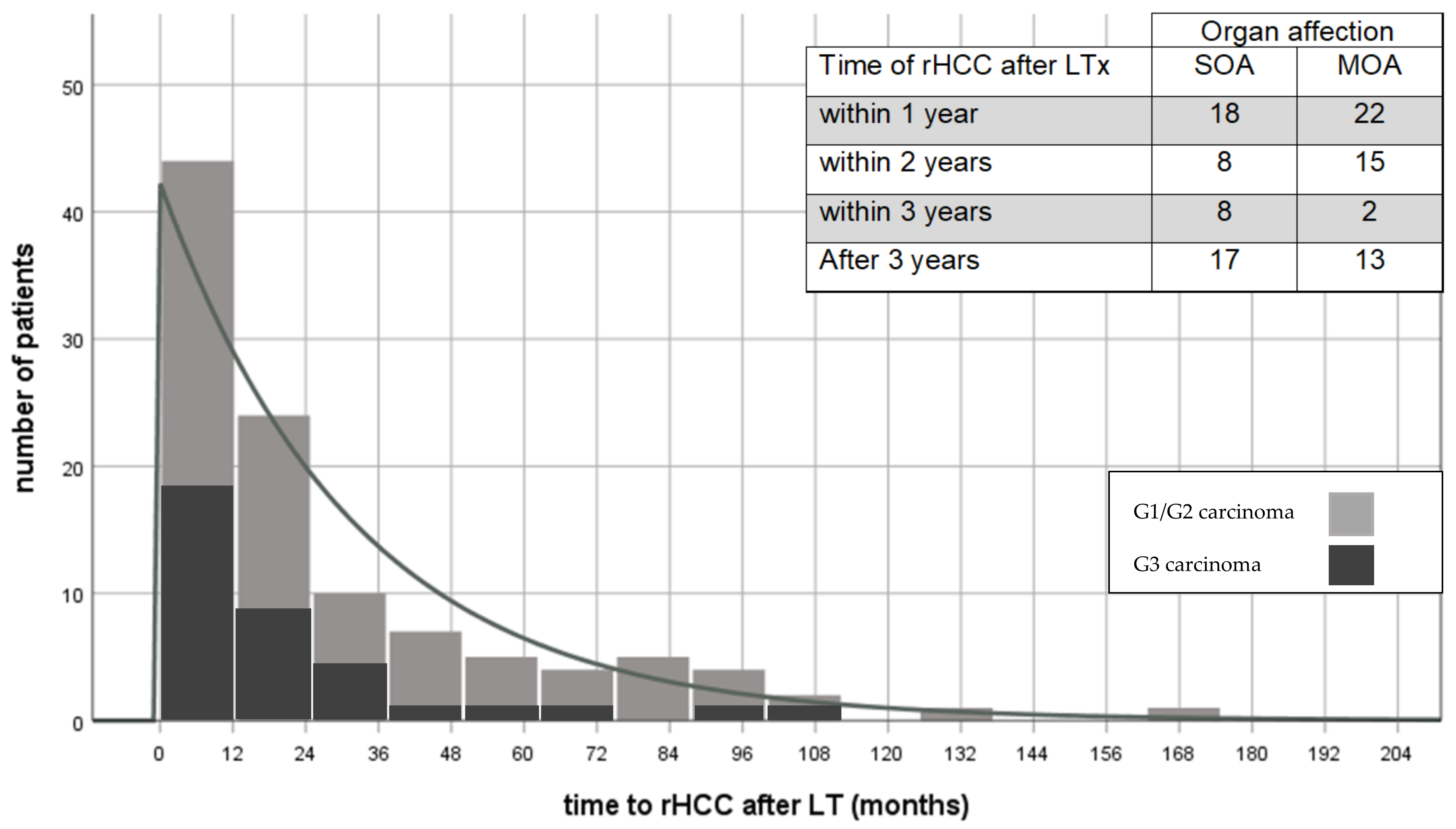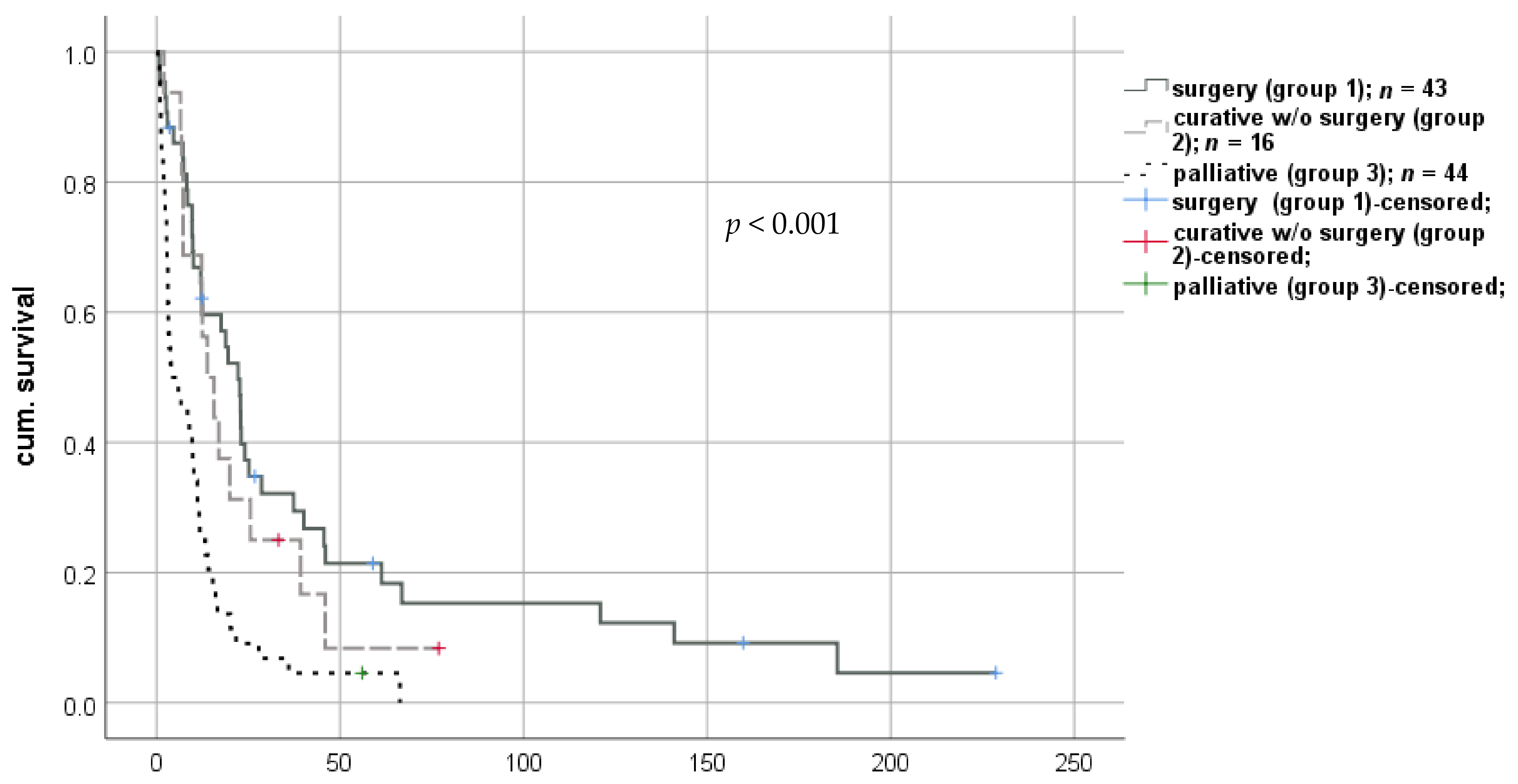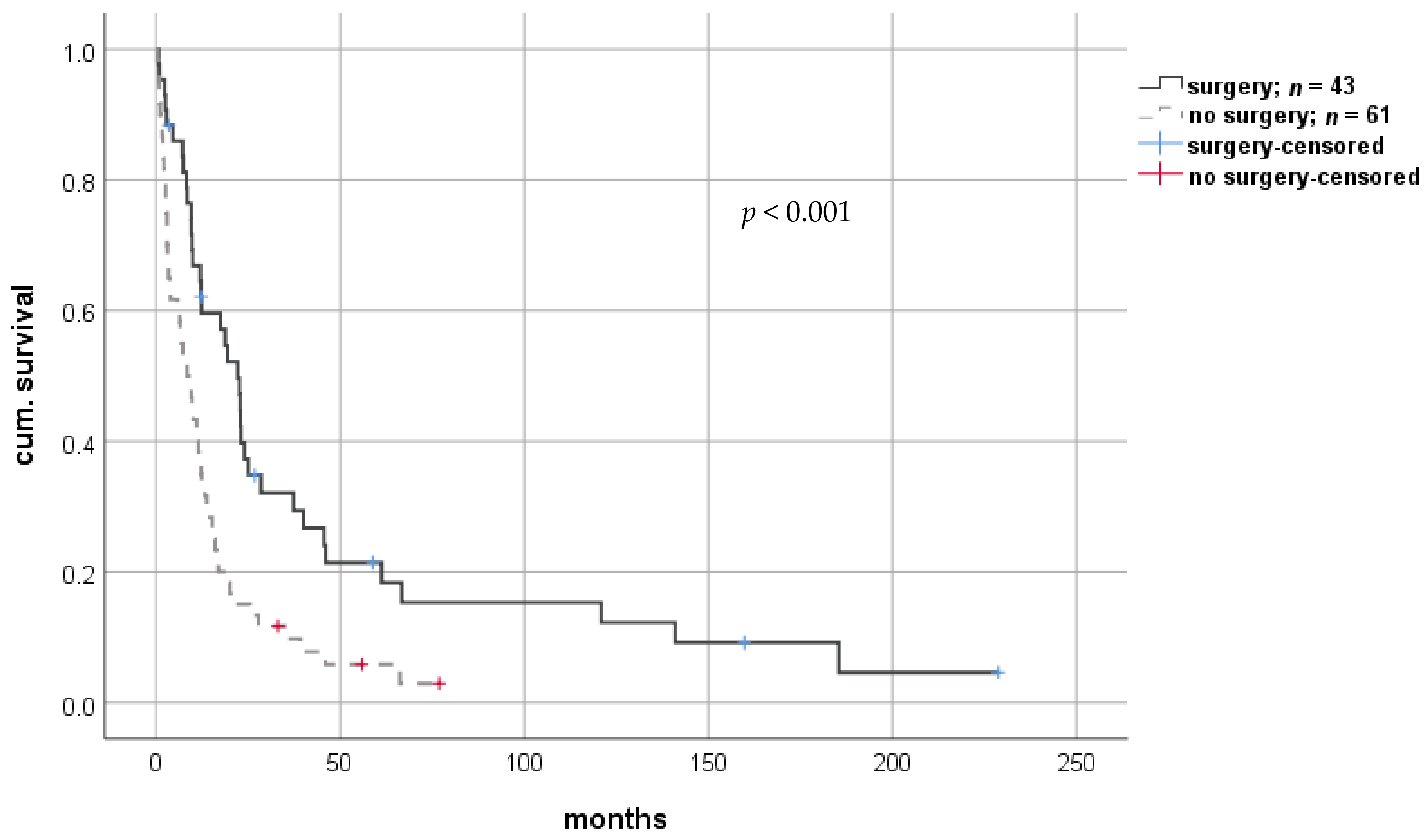Minimization of Immunosuppressive Therapy Is Associated with Improved Survival of Liver Transplant Patients with Recurrent Hepatocellular Carcinoma
Abstract
Simple Summary
Abstract
1. Introduction
2. Patients and Methods
3. Results
4. Discussion
5. Conclusions
Author Contributions
Funding
Institutional Review Board Statement
Informed Consent Statement
Data Availability Statement
Conflicts of Interest
Abbreviations
| AFP | alpha-fetoprotein |
| BSC | best supportive care |
| CCC | cholangiocellular carcinoma |
| CNI | calcineurin inhibitors |
| CYA | cyclosporine A |
| HBV | hepatitis B virus |
| HCV | hepatitis C virus |
| HCC | hepatocellular carcinoma |
| IQR | interquartile range |
| LT | liver transplantation |
| MMF | mycophenolate mofetil |
| MOA | multi-organ affection |
| MWA | microwave ablation |
| mTORI | mammalian target of rapamycin inhibitors |
| NA | nucleos(t)id-analog |
| PCR | polymerase chain reaction |
| RFA | radio frequency ablation |
| RFS | recurrence free survival |
| rHCC | recurrent hepatocellular carcinoma |
| RIM | restrictive immunosuppressive management |
| SOA | single-organ affection |
| TACE | transarterial chemoembolization |
References
- Lee, D.D.; Sapisochin, G.; Mehta, N.; Gorgen, A.; Musto, K.R.; Hajda, H.; Yao, F.Y.; Hodge, D.O.; Carter, R.E.; Harnois, D.M. Surveillance for HCC after liver transplantation: Increased monitoring may yield aggressive treatment options and improved postrecurrence survival. Transplantation 2020, 104, 2105–2112. [Google Scholar] [CrossRef] [PubMed]
- De’angelis, N.; Landi, F.; Carra, M.C.; Azoulay, D. Managements of recurrent hepatocellular carcinoma after liver transplantation: A systematic review. World J. Gastroenterol. 2015, 21, 11185–11198. [Google Scholar] [CrossRef] [PubMed]
- Samoylova, M.L.; Dodge, J.L.; Yao, F.Y.; Roberts, J.P. Time to transplantation as a predictor of hepatocellular carcinoma recurrence after liver transplantation. Liver Transpl. 2014, 20, 937–944. [Google Scholar] [CrossRef] [PubMed]
- Lerut, J.; Iesari, S.; Foguenne, M.; Lai, Q. Hepatocellular cancer and recurrence after liver transplantation: What about the impact of immunosuppression? Transl. Gastroenterol. Hepatol. 2017, 2, 80. [Google Scholar] [CrossRef]
- Moini, M.; Schilsky, M.L.; Tichy, E.M. Review on immunosuppression in liver transplantation. World J. Hepatol. 2015, 7, 1355–1368. [Google Scholar] [CrossRef]
- Verna, E.C.; Patel, Y.A.; Aggarwal, A.; Desai, A.P.; Frenette, C.; Pillai, A.A.; Salgia, R.; Seetharam, A.; Sharma, P.; Sherman, C.; et al. Liver transplantation for hepatocellular carcinoma: Management after the transplant. Am. J. Transpl. 2020, 20, 333–347. [Google Scholar] [CrossRef]
- Vivarelli, M.; Dazzi, A.; Zanello, M.; Cucchetti, A.; Cescon, M.; Ravaioli, M.; Del Gaudio, M.; Lauro, A.; Grazi, G.L.; Pinna, A.D. Effect of different immunosuppressive schedules on recurrence-free survival after liver transplantation for hepatocellular carcinoma. Transplantation 2010, 89, 227–231. [Google Scholar] [CrossRef]
- Geissler, E.K.; Schnitzbauer, A.A.; Zülke, C.; Lamby, P.E.; Proneth, A.; Duvoux, C.; Burra, P.; Jauch, K.W.; Rentsch, M.; Ganten, T.M.; et al. Sirolimus use in liver transplant recipients with hepatocellular carcinoma: A randomized, multicenter, open-label phase 3 trial. Transplantation 2016, 100, 116–125. [Google Scholar] [CrossRef]
- Berenguer, M.; Burra, P.; Ghobrial, M.; Hibi, T.; Metselar, H.; Sapisochin, G.; Bhoori, S.; Man, N.K.; Mas, V.; Ohira, M.; et al. Posttransplant management of recipients undergoing liver transplantation for hepatocellular carcinoma. Working Group Report from the ILTS Transplant Oncology Consensus Conference. Transplantation 2020, 104, 1143–1149. [Google Scholar] [CrossRef]
- Goodman, Z.D. Grading and staging systems for inflammation and fibrosis in chronic liver diseases. J. Hepatol. 2007, 47, 598–607. [Google Scholar] [CrossRef]
- Nowicki, T.K.; Markiet, K.; Szurowska, E. Diagnostic imaging of hepatocellular carcinoma—A pictorial essay. Curr. Med. Imaging Rev. 2017, 13, 140–153. [Google Scholar] [CrossRef]
- Edmondson, H.A.; Steiner, P.E. Primary carcinoma of the liver: A study of 100 cases among 48,900 necropsies. Cancer 1954, 7, 462–503. [Google Scholar] [CrossRef]
- Roayaie, S.; Schwartz, J.D.; Sung, M.W.; Emre, S.H.; Miller, C.M.; Gondolesi, G.E.; Krieger, N.R.; Schwartz, M.E. Recurrence of hepatocellular carcinoma after liver transplant: Patterns and prognosis. Liver Transpl. 2004, 10, 534–540. [Google Scholar] [CrossRef]
- Kornberg, A.; Küpper, B.; Tannapfel, A.; Katenkamp, K.; Thrum, K.; Habrecht, O.; Wilberg, J. Long-term survival after recurrent hepatocellular carcinoma in liver transplant patients: Clinical patterns and outcome variables. Eur. J. Surg. Oncol. 2010, 36, 275–280. [Google Scholar] [CrossRef]
- Chok, K. Management of recurrent hepatocellular carcinoma after liver transplant. World J. Hepatol. 2015, 7, 1142–1148. [Google Scholar] [CrossRef]
- Au, K.P.; Chok, K.S.H. Multidisciplinary approach for post-liver transplant recurrence of hepatocellular carcinoma: A proposed management algorithm. World J. Gastroenterol. 2018, 24, 5081–5094. [Google Scholar] [CrossRef]
- Fernandez-Sevilla, E.; Allard, M.A.; Selten, J.; Golse, N.; Vibert, E.; Sa Cunha, A.; Cherqui, D.; Castaing, D.; Adam, R. Recurrence of hepatocellular carcinoma after liver transplantation: Is there a place for resection? Liver Transpl. 2017, 23, 440–447. [Google Scholar] [CrossRef]
- Sarici, B.; Isik, B.; Yilmaz, S. Management of recurrent HCC after liver transplantation. J. Gastrointest. Cancer 2020. [Google Scholar] [CrossRef]
- Mazzola, A.; Costantino, A.; Petta, S.; Bartolotta, T.V.; Raineri, M.; Sacco, R.; Brancatelli, G.; Cammà, C.; Cabibbo, G. Recurrence of hepatocellular carcinoma after liver transplantation: An update. Future Oncol. 2015, 11, 2923–2936. [Google Scholar] [CrossRef]
- Pohl, J.M.O.; Raschzok, N.; Eurich, D.; Pflüger, M.; Wiering, L.; Daneshgar, A.; Dziodzio, T.; Jara, M.; Globke, B.; Sauer, I.M.; et al. Outcomes of liver resections after liver transplantation at a high-volume hepatobiliary center. J. Clin. Med. 2020, 9, 3685. [Google Scholar] [CrossRef]
- Greten, T.F.; Malek, N.P.; Schmidt, S.; Arends, J.; Bartenstein, P.; Bechstein, W.; Bernatik, T.; Bitzer, M.; Chavan, A.; Dollinger, M.; et al. Diagnosis of and therapy for hepatocellular carcinoma. Z. Gastroenterol. 2013, 51, 1269–1326. [Google Scholar] [CrossRef]
- Bodzin, A.S.; Lunsford, K.E.; Markovic, D.; Harlander-Locke, M.P.; Busuttil, R.W.; Agopian, V.G. Predicting mortality in patients developing recurrent hepatocellular carcinoma after liver transplantation: Impact of treatment modality and recurrence characteristics. Ann. Surg. 2017, 266, 118–125. [Google Scholar] [CrossRef]
- Schnitzbauer, A.A.; Filmann, N.; Adam, R.; Bachellier, P.; Bechstein, W.O.; Becker, T.; Bhoori, S.; Bilbao, I.; Brockmann, J.; Burra, P.; et al. mTOR inhibition is most beneficial after liver transplantation for hepatocellular carcinoma in patients with active tumors. Ann. Surg. 2020, 272, 855–862. [Google Scholar] [CrossRef]
- Wasilewicz, M.P.; Moczydłowska, D.; Janik, M.; Grąt, M.; Zieniewicz, K.; Raszeja-Wyszomirska, J. Immunosuppressive treatment with everolimus in patients after liver transplant: 4 years of single-center experience. Pol. Arch. Intern. Med. 2019, 129, 686–691. [Google Scholar] [CrossRef]
- Fischer, L.; Saliba, F.; Kaiser, G.M.; De Carlis, L.; Metselaar, H.J.; De Simone, P.; Duvoux, C.; Nevens, F.; Fung, J.J.; Dong, G.; et al. Three-year outcomes in de novo liver transplant patients receiving everolimus with reduced tacrolimus: Follow-up results from a randomized, multicenter study. Transplantation 2015, 99, 1455–1462. [Google Scholar] [CrossRef]
- Cholongitas, E.; Goulis, I.; Theocharidou, E.; Antoniadis, N.; Fouzas, I.; Giakoustidis, D.; Imvrios, G.; Giouleme, O.; Papanikolaou, V.; Akriviadis, E.; et al. Everolimus-based immunosuppression in liver transplant recipients: A single-centre experience. Hepatol. Int. 2014, 8, 137–145. [Google Scholar] [CrossRef]
- Navarro-Villarán, E.; Tinoco, J.; Jiménez, G.; Pereira, S.; Wang, J.; Aliseda, S.; Rodríguez-Hernández, M.A.; González, R.; Marín-Gómez, L.M.; Gómez-Bravo, M.A.; et al. Differential antitumoral properties and renal-associated tissue damage induced by tacrolimus and mammalian target of rapamycin inhibitors in hepatocarcinoma: In vitro and in vivo studies. PLoS ONE 2016, 11, e0160979. [Google Scholar] [CrossRef] [PubMed]
- Hussaini, T.; Erb, S.; Yoshida, E.M. Immunosuppressive pharmacotherapy in liver transplantation. AME Med. J. 2018, 3, 18. [Google Scholar] [CrossRef]
- Francke, M.I.; de Winter, B.C.M.; Elens, L.; Lloberas, N.; Hesselink, D.A. The pharmacogenetics of tacrolimus and its implications for personalized therapy in kidney transplant recipients. Expert Rev. Precis. Med. Drug Dev. 2020, 5, 313–316. [Google Scholar] [CrossRef]
- Bruns, H.; Raab, H.R.; Yamanaka, K.; Strupas, K.; Schemmer, P. Challenges in liver transplantation. Visc. Med. 2016, 32, 290–293. [Google Scholar] [CrossRef] [PubMed]
- Ponticelli, C.; Glassock, R.J. Prevention of complications from use of conventional immunosuppressants: A critical review. J. Nephrol. 2019, 32, 851–870. [Google Scholar] [CrossRef] [PubMed]
- Stucker, F.; Ackermann, D. Immunosuppressive drugs—How they work, their side effects and interactions. Ther. Umsch. 2011, 68, 679–686. [Google Scholar] [CrossRef] [PubMed]
- Vivarelli, M.; Cucchetti, A.; La Barba, G.; Ravaioli, M.; Del Gaudio, M.; Lauro, A.; Grazi, G.L.; Pinna, A.D. Liver transplantation for hepatocellular carcinoma under calcineurin inhibitors: Reassessment of risk factors for tumor recurrence. Ann. Surg. 2008, 248, 857–862. [Google Scholar] [CrossRef] [PubMed]
- Vivarelli, M.; Cucchetti, A.; Piscaglia, F.; La Barba, G.; Bolondi, L.; Cavallari, A.; Pinna, A.D. Analysis of risk factors for tumor recurrence after liver transplantation for hepatocellular carcinoma: Key role of immunosuppression. Liver Transplant. 2005, 11, 497–503. [Google Scholar] [CrossRef]
- Manzia, T.M.; Angelico, R.; Gazia, C.; Lenci, I.; Milana, M.; Ademoyero, O.T.; Pedini, D.; Toti, L.; Spada, M.; Tisone, G.; et al. De novo malignancies after liver transplantation: The effect of immunosuppression-personal data and review of literature. World J. Gastroenterol. 2019, 25, 5356–5375. [Google Scholar] [CrossRef]






| All Patients with rHCC after LT | n = 112 | |
|---|---|---|
| Sex (%) | ||
| male | 100 (89.3) | |
| female | 12 (10.7) | |
| Etiologies of HCC (%) | Recurrence after LT | |
| HCV | 42 (37.5) | 33 (78.6) |
| HBV | 15 (13.4) | 6 (40) |
| alcohol | 39 (34.8) | 2 (0.05) |
| cryptic | 11 (9.8) | - |
| hereditary disorders | 3 (2.7) | - |
| autoimmune | 2 (1.8) | - |
| Comorbidities (%) | ||
| Diabetes mellitus | 33 (29.5) | |
| Obesity (BMI > 30 kg/m2) | 17 (15.2) | |
| Arteriosclerosis | 10 (8.9) | |
| COPD | 7 (6.3) | |
| Edmonson–Steiner Grade of HCC (%) | ||
| G1 | 5 (4.8) | |
| G2 | 67 (64.4) | |
| G3 | 32 (30.8) | |
| Re-transplantation (%) | 3 (2.7) | |
| Combined kidney transplantation (%) | 3 (2.7) | |
| Median age at LT in years (min–max; Q1–Q3) | 58 (31–72; 53–62) | |
| Date of LT (%) | ||
| 1989–1999 | 31 (27.7) | |
| 2000–2009 | 66 (58.9) | |
| 2009–2019 | 15 (13.4) | |
| Within MILAN-criteria according to histopathology (%) | ||
| yes | 28 (25%) | |
| no | 75 (76%) | |
| Onset of rHCC (n = 108) (%) | ||
| <2 years | 68 (63.0) | |
| >2 years | 40 (37.0) | |
| Median time to rHCC in months (min–max; Q1–Q3) | 16.0 (1.0–230.0; 8.3–44.0) | |
| Median time of survival after rHCC in months (min–max; Q1–Q3) | 10.6 (0.3–228.7; 3.3–22.9) | |
| Median AFP-levels in ng/mL (min–max; Q1–Q3) | ||
| before LT (n = 96) | 45.5 (1.0–1,072,817.0; 8.0–355.8) | |
| before rHCC (n = 78) | 7.5 (1.0–124,254.0; 3.0–98.8) | |
| at rHCC (n = 75) | 72.0 (1.0–605,505.0; 5.0–954.0) | |
| rHCC manifestation at time of diagnosis (%) | ||
| liver only | 15 (13.4) | |
| extrahepatic | 56 (50) | |
| combined | 32 (28.6) | |
| Oncological regimen for rHCC (n =103) | ||
| Curative (%) | 59 (57.3) | |
| Palliative (%) | 44 (42.3) | |
| IS regimen (n = 103) | before rHCC | after rHCC |
| CNI-mono (%) | 34 (33.0) | 28 (27.2) |
| mTORI-mono (%) | 7 (6.8) | 18 (17.5) |
| CNI + MMF (%) | 35 (34.0) | 22 (21.3) |
| CNI + GC (%) | 9 (8.7) | 7 (6.8) |
| CNI + mTORI (%) | 9 (8.7) | 11 (10.7) |
| Others (%) | 9 (8.7) | 14 (13.6) |
| no IS (%) | 0 (0) | 3 (2.9) |
| Status at last follow-up (n = 112) | ||
| alive (%) | 9 (8.0) | |
| deceased (%) | 103 (92.0) | |
| tumor progression | 107 (95.5) | |
| others | 5 (4.5) | |
| Parameters | n | p | Hazard Ratio | 95% CI | |
|---|---|---|---|---|---|
| Lower | Upper | ||||
| Age | 90 | 0.35 | 1.0 | ||
| Obesity | 17 | 0.40 | 0.74 | 0.37 | 1.50 |
| Diabetes mellitus | 30 | 0.95 | 0.56 | 1.59 | |
| Oncological therapy | |||||
| surgery | 37 | <0.000 | 0.35 | 0.20 | 0.61 |
| radiotherapy | 15 | 0.131 | 0.57 | 0.27 | 1.18 |
| palliative (reference) | 38 | 0.001 | |||
| Recurrent HCV-infection | |||||
| Yes | 26 | 0.93 | 1.03 | 0.54 | 1.95 |
| No | 7 | 0.7 | 0.82 | 0.30 | 2.23 |
| Without HCV at LT (reference) | 57 | 0.91 | |||
| Recurrent HBV-infection | |||||
| Yes | 5 | 0.31 | 1.68 | 0.61 | 4.62 |
| No | 8 | 0.56 | 0.76 | 0.30 | 1.94 |
| Without HBV at LT (reference) | 77 | 0.46 | |||
| Histological grading | |||||
| G1 | 2 | 0.243 | 0.41 | 0.09 | 1.84 |
| G2 | 59 | 0.007 | 0.46 | 0.29 | 0.82 |
| G3 (reference) | 29 | 0.025 | |||
| Extent of recurrence | 0.007 | 0.50 | 0.30 | 0.83 | |
| Single-organ | 44 | ||||
| Multi-organ | 46 | ||||
| Restrictive immunosuppression | 59 | 0.026 | 0.55 | 0.32 | 0.93 |
Publisher’s Note: MDPI stays neutral with regard to jurisdictional claims in published maps and institutional affiliations. |
© 2021 by the authors. Licensee MDPI, Basel, Switzerland. This article is an open access article distributed under the terms and conditions of the Creative Commons Attribution (CC BY) license (https://creativecommons.org/licenses/by/4.0/).
Share and Cite
Ossami Saidy, R.R.; Postel, M.P.; Pflüger, M.J.; Schoening, W.; Öllinger, R.; Gül-Klein, S.; Schmelzle, M.; Tacke, F.; Pratschke, J.; Eurich, D. Minimization of Immunosuppressive Therapy Is Associated with Improved Survival of Liver Transplant Patients with Recurrent Hepatocellular Carcinoma. Cancers 2021, 13, 1617. https://doi.org/10.3390/cancers13071617
Ossami Saidy RR, Postel MP, Pflüger MJ, Schoening W, Öllinger R, Gül-Klein S, Schmelzle M, Tacke F, Pratschke J, Eurich D. Minimization of Immunosuppressive Therapy Is Associated with Improved Survival of Liver Transplant Patients with Recurrent Hepatocellular Carcinoma. Cancers. 2021; 13(7):1617. https://doi.org/10.3390/cancers13071617
Chicago/Turabian StyleOssami Saidy, Ramin Raul, Maximilian Paul Postel, Michael Johannes Pflüger, Wenzel Schoening, Robert Öllinger, Safak Gül-Klein, Moritz Schmelzle, Frank Tacke, Johann Pratschke, and Dennis Eurich. 2021. "Minimization of Immunosuppressive Therapy Is Associated with Improved Survival of Liver Transplant Patients with Recurrent Hepatocellular Carcinoma" Cancers 13, no. 7: 1617. https://doi.org/10.3390/cancers13071617
APA StyleOssami Saidy, R. R., Postel, M. P., Pflüger, M. J., Schoening, W., Öllinger, R., Gül-Klein, S., Schmelzle, M., Tacke, F., Pratschke, J., & Eurich, D. (2021). Minimization of Immunosuppressive Therapy Is Associated with Improved Survival of Liver Transplant Patients with Recurrent Hepatocellular Carcinoma. Cancers, 13(7), 1617. https://doi.org/10.3390/cancers13071617










